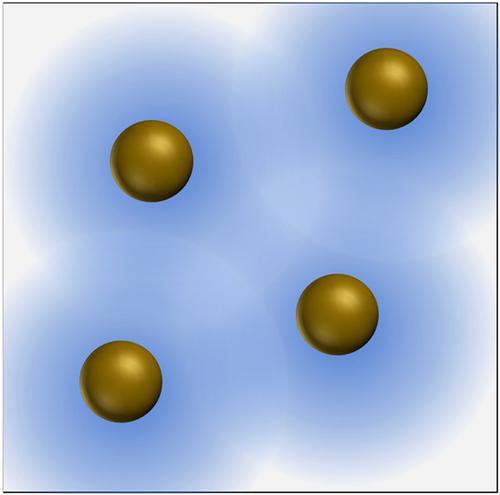当前位置:
X-MOL 学术
›
Plasma Processes Polym.
›
论文详情
Our official English website, www.x-mol.net, welcomes your
feedback! (Note: you will need to create a separate account there.)
Interfacial region effect on thermal conductivity of silicon nanocrystal and polystyrene nanocomposites
Plasma Processes and Polymers ( IF 2.9 ) Pub Date : 2020-01-16 , DOI: 10.1002/ppap.201900212 Firman Bagja Juangsa 1 , Meguya Ryu 2 , Junko Morikawa 2 , Tomohiro Nozaki 3
Plasma Processes and Polymers ( IF 2.9 ) Pub Date : 2020-01-16 , DOI: 10.1002/ppap.201900212 Firman Bagja Juangsa 1 , Meguya Ryu 2 , Junko Morikawa 2 , Tomohiro Nozaki 3
Affiliation

|
Thermal transport has been widely studied in nanosize materials owing to their unique properties, including size‐dependent thermal transport properties. Bulk‐size nanostructures are often used for thermal property investigation as well as device applications. The nanocomposite structure of silicon nanocrystals (SiNCs) and polystyrene (PS) has been reported to have a significant thermal transport suppression attributed to the thermal resistance at material interfaces. Although the theoretical effective medium approximation (EMA) model for nanocomposites considers the thermal boundary resistance, a constant deviation is observed between the model and measurement results. In this study, the thermal transport of a polymer, which is known to be morphology dependent, is investigated in a region near the interfacial boundary. Nanocomposites were fabricated from SiNCs with significantly different diameters (6 and 60 nm), and their thermal conductivity was measured to analyze the effect of particle size on the effective thermal conductivity and its deviation. The results showed that the interfacial region of the PS matrix significantly affects the thermal transport, and the EMA model can be enhanced by modifying the thermal conductivity of the matrix owing to the confinement effect at the interfacial region; and the model and measurement results are in good agreement. This study shows that the interaction at material interfaces and its effect on the interfacial region play an important role in determining the thermal transport, opening up the possibility of controlling the thermal transport properties for wide applications of polymer‐based nanocomposite devices.
中文翻译:

界面区域对硅纳米晶体和聚苯乙烯纳米复合材料导热系数的影响
由于纳米材料的独特性能,包括尺寸依赖性的热传输性能,热传输已被广泛研究。大体积的纳米结构通常用于热性能研究以及设备应用。据报道,硅纳米晶体(SiNCs)和聚苯乙烯(PS)的纳米复合结构具有显着的热传输抑制作用,这归因于材料界面处的热阻。尽管理论上纳米复合材料的有效介质近似(EMA)模型考虑了热边界电阻,但在模型和测量结果之间观察到了恒定偏差。在这项研究中,在界面边界附近的区域中研究了聚合物的热传输,该聚合物依赖于形态。由直径显着不同(6和60 nm)的SiNC制造纳米复合材料,并测量其导热系数,以分析粒径对有效导热系数及其偏差的影响。结果表明,PS基体的界面区域显着影响热传递,由于界面区域的约束作用,可以通过改变基体的导热系数来增强EMA模型。模型与测量结果吻合良好。这项研究表明,材料界面处的相互作用及其对界面区域的影响在确定热传递方面起着重要作用,从而为控制基于聚合物的纳米复合材料器件的广泛应用提供了控制热传递特性的可能性。
更新日期:2020-01-16
中文翻译:

界面区域对硅纳米晶体和聚苯乙烯纳米复合材料导热系数的影响
由于纳米材料的独特性能,包括尺寸依赖性的热传输性能,热传输已被广泛研究。大体积的纳米结构通常用于热性能研究以及设备应用。据报道,硅纳米晶体(SiNCs)和聚苯乙烯(PS)的纳米复合结构具有显着的热传输抑制作用,这归因于材料界面处的热阻。尽管理论上纳米复合材料的有效介质近似(EMA)模型考虑了热边界电阻,但在模型和测量结果之间观察到了恒定偏差。在这项研究中,在界面边界附近的区域中研究了聚合物的热传输,该聚合物依赖于形态。由直径显着不同(6和60 nm)的SiNC制造纳米复合材料,并测量其导热系数,以分析粒径对有效导热系数及其偏差的影响。结果表明,PS基体的界面区域显着影响热传递,由于界面区域的约束作用,可以通过改变基体的导热系数来增强EMA模型。模型与测量结果吻合良好。这项研究表明,材料界面处的相互作用及其对界面区域的影响在确定热传递方面起着重要作用,从而为控制基于聚合物的纳米复合材料器件的广泛应用提供了控制热传递特性的可能性。











































 京公网安备 11010802027423号
京公网安备 11010802027423号